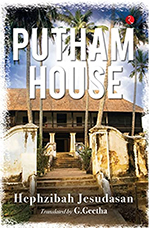Riveting drama demands neither a large amphitheatre nor elaborate stage settings. It can happen in a nondescript village dotted with palmyra trees amidst which sits an old house, ‘huge and rambling, in near ruins’, inappropriately called Putham Veedu (New House). The cast is ready to hand…real people living their real lives within the limitations of societal norms.
The storytelling is devoid of artifice. Nothing is said for effect. There are no clever twists and turns of the plot. Because there is no ‘plot’. It is a genre one could term as ‘realistic fiction’, and it works exceptionally well here. After leading the reader by the hand into the village and its ecosystem of abundant flora and fauna dominated by palmyra trees, palmyra trees, and more palmyra trees, the author sets about introducing the cast of characters.
We meet the family at Putham Veedu. Lizzy, a sprightly dusky girl, affectionate, caring, obedient, but with dreams of her own. Her drunkard, good-for-nothing father who visits the local toddy shop regularly, her weepy mother with her ineffective protests, her Chithappa who has grandiose ambitions but not the talent to achieve anything, her Chithi, with relatives in Thiruvananthapuram who may or may not be helpful, their daughter Lily, fair complexioned unlike her older cousin Lizzy, the grandmother Kannammai who has mastered the skill of coping with her family’s whims and surviving whatever life may throw at her. And, literally in the forefront of it all, lounging in the adichikootu that runs along the front of the house, the old grandfather, Kannapachi, who bemoans his fate and his wastrel sons, dotes upon Lizzy, still commands the respect traditionally shown towards the elder in the family, and often spits, ‘Thoo!’
A word about the literary style. There are examples of onomatopoeia liberally sprinkled across the pages. The ‘charak charak’ of the palmyra climber shinning up the palm tree is a constant refrain. This kind of thing could potentially be jarring to the reader; but somehow here the sound effects are endearing. They underscore the predictability of age-old seasonal tasks, and send the message that some things cannot stop even for weddings and funerals. Like a good background score in an action movie, the ‘charak charak’ as well as the ‘Koo! Koo!’ calls of the panaiyeris (palmyra climbers) from the treetops, and even the ‘thoo’ of the grandfather spitting out betel are motifs that bring the drama alive.
When we first meet Lizzy, she is a carefree young girl, still young enough to move around the village freely and drop in frequently to visit with her friend Mary at the Mission House of the Upadesiar. She even gets to go to school. School is a whole new world for Lizzy. It is also where she meets someone with whom her destiny is linked. That someone is a palmyra climber’s son Thangaraj, whom she tutors in maths. She gifts him a peacock feather to comfort him after he receives a caning from the schoolmaster.

